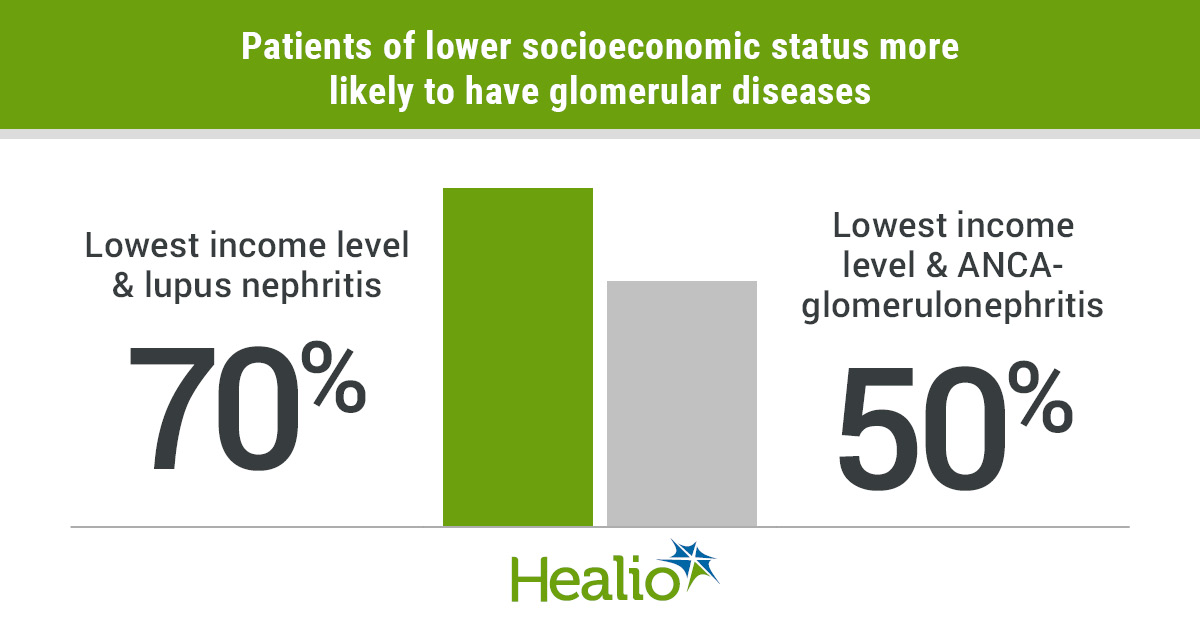Lower socioeconomic status associated with greater incidence of glomerular diseases
Click Here to Manage Email Alerts
Patients of lower socioeconomic status, determined through area-level household income, had a greater incidence of both ANCA-related glomerulonephritis and lupus nephritis, according to study results from British Columbia, Canada.
“Glomerular diseases are complex conditions that require access to specialized care and expensive therapies, all of which may be more challenging for patients with a lower socioeconomic position,” Mark Canney, PhD, of the University of British Columbia, said in a related press release. “Also, they tend to affect people at a younger age and can thus negatively impact an individual’s earning capacity.”
Suggesting “an improved understanding of the potential contribution of socioeconomic position to different glomerular diseases could generate ideas for future research into factors that may directly cause glomerular disease,” Canney and colleagues used a provincial kidney pathology database to identify incident cases of membranous nephropathy (n = 392), IgA nephropathy (n = 818), focal segmental glomerulosclerosis ([FSGS] n = 375), ANCA-related glomerulonephritis (n = 387) and lupus nephritis (n = 389). After accounting for regional differences in living costs, they determined individuals’ socioeconomic positions, dividing area-level household income into quintiles.
They found the incidence of lupus nephritis and ANCA-glomerulonephritis increased steadily with progressively lower income. For lupus nephritis, the standardized incidence rate in women increased from 1.06 in the highest quintile to 1.81 in the lowest, leading to a 70% higher incidence for those with the lowest income. For ANCA-glomerulonephritis, the standardized incidence rate increased from 0.71 in the highest quintile to 1.06 in the lowest, leading to a 50% higher incidence.

As “patients with glomerular disease require highly specialized nephrology care, vigilant follow-up and access to increasingly expensive therapies,” the researchers argued “a vicious cycle may ensue in which individuals at lower socioeconomic position are more likely to get glomerular disease, encounter barriers to accessing optimal care, progress to ESKD and then experience further financial losses, thereby exacerbating their socioeconomic situation.”
In a related editorial, Michelle M. O’Shaughnessy, MD, of Cork University Hospital Group in Ireland, suggested that in addition to looking at socioeconomic position through income, further studies should explore the link between “individual elements of this social construct” — including birth history, traumatic childhood experiences, psychological or social stress, diet, occupation and pollution — and glomerular disease risk.
“In the meantime, based on the insights provided by Canney and colleagues, clinicians and investigators should have a renewed focus on socioeconomic position when evaluating patients with suspected glomerular disease, determining recruitment populations for clinical trials or designing observational studies aimed at identifying risk factors for glomerular disease onset,” she wrote. – by Melissa J. Webb
Disclosures: Canney reports no relevant financial disclosures. Please see the study for all other authors’ relevant financial disclosures.
